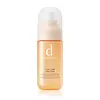What's inside
What's inside
 Key Ingredients
Key Ingredients

No key ingredients
 Benefits
Benefits

 Concerns
Concerns

No concerns
 Ingredients Side-by-side
Ingredients Side-by-side

Water
Skin ConditioningGlycerin
HumectantParaffinum Liquidum
EmollientButylene Glycol
HumectantCoix Lacryma-Jobi Ma-Yuen Seed Extract
Skin ConditioningBetaine
HumectantCholesteryl/Octyldodecyl Lauroyl Glutamate
Skin ConditioningHydroxyethyl Acrylate/Sodium Acryloyldimethyl Taurate Copolymer
Emulsion StabilisingAcrylates/C10-30 Alkyl Acrylate Crosspolymer
Emulsion StabilisingPolyglyceryl-10 Eicosanedioate/Tetradecanedioate
Skin ConditioningPEG-150
HumectantSodium Hydroxide
BufferingSorbitan Isostearate
EmulsifyingIsohexadecane
EmollientStearic Acid
CleansingSucrose Stearate
EmollientSorbitan Sesquioleate
EmulsifyingSodium Palmoyl Glutamate
CleansingBehenyl Alcohol
EmollientPolysorbate 60
EmulsifyingMethyl Gluceth-10
EmulsifyingMethylparaben
PreservativeWater, Glycerin, Paraffinum Liquidum, Butylene Glycol, Coix Lacryma-Jobi Ma-Yuen Seed Extract, Betaine, Cholesteryl/Octyldodecyl Lauroyl Glutamate, Hydroxyethyl Acrylate/Sodium Acryloyldimethyl Taurate Copolymer, Acrylates/C10-30 Alkyl Acrylate Crosspolymer, Polyglyceryl-10 Eicosanedioate/Tetradecanedioate, PEG-150, Sodium Hydroxide, Sorbitan Isostearate, Isohexadecane, Stearic Acid, Sucrose Stearate, Sorbitan Sesquioleate, Sodium Palmoyl Glutamate, Behenyl Alcohol, Polysorbate 60, Methyl Gluceth-10, Methylparaben
Water
Skin ConditioningDipropylene Glycol
HumectantButylene Glycol
HumectantGlycerin
HumectantCyclopentasiloxane
EmollientTranexamic Acid
AstringentErythritol
HumectantPEG/PPG-17/4 Dimethyl Ether
Skin ConditioningDipotassium Glycyrrhizate
HumectantAllantoin
Skin ConditioningXanthan Gum
EmulsifyingPhytosteryl/Octyldodecyl Lauroyl Glutamate
Skin ConditioningPEG/PPG-14/7 Dimethyl Ether
Skin ConditioningLamium Album Flower/Leaf/Stem Extract
Skin ConditioningPhellodendron Amurense Bark Extract
Skin ConditioningDimethicone
EmollientCarbomer
Emulsion StabilisingAcrylates/C10-30 Alkyl Acrylate Crosspolymer
Emulsion StabilisingSodium Metabisulfite
AntioxidantTocopherol
AntioxidantPhenoxyethanol
PreservativeWater, Dipropylene Glycol, Butylene Glycol, Glycerin, Cyclopentasiloxane, Tranexamic Acid, Erythritol, PEG/PPG-17/4 Dimethyl Ether, Dipotassium Glycyrrhizate, Allantoin, Xanthan Gum, Phytosteryl/Octyldodecyl Lauroyl Glutamate, PEG/PPG-14/7 Dimethyl Ether, Lamium Album Flower/Leaf/Stem Extract, Phellodendron Amurense Bark Extract, Dimethicone, Carbomer, Acrylates/C10-30 Alkyl Acrylate Crosspolymer, Sodium Metabisulfite, Tocopherol, Phenoxyethanol
 Reviews
Reviews

Ingredients Explained
These ingredients are found in both products.
Ingredients higher up in an ingredient list are typically present in a larger amount.
Acrylates/C10-30 Alkyl Acrylate Crosspolymer is a synthetic polymer. It is used to thicken and improve the texture of products. Due to its properties, it can prevent water and oil ingredients from separating.
Butylene Glycol (or BG) is used within cosmetic products for a few different reasons:
Overall, Butylene Glycol is a safe and well-rounded ingredient that works well with other ingredients.
Though this ingredient works well with most skin types, some people with sensitive skin may experience a reaction such as allergic rashes, closed comedones, or itchiness.
Learn more about Butylene GlycolGlycerin is already naturally found in your skin. It helps moisturize and protect your skin.
A study from 2016 found glycerin to be more effective as a humectant than AHAs and hyaluronic acid.
As a humectant, it helps the skin stay hydrated by pulling moisture to your skin. The low molecular weight of glycerin allows it to pull moisture into the deeper layers of your skin.
Hydrated skin improves your skin barrier; Your skin barrier helps protect against irritants and bacteria.
Glycerin has also been found to have antimicrobial and antiviral properties. Due to these properties, glycerin is often used in wound and burn treatments.
In cosmetics, glycerin is usually derived from plants such as soybean or palm. However, it can also be sourced from animals, such as tallow or animal fat.
This ingredient is organic, colorless, odorless, and non-toxic.
Glycerin is the name for this ingredient in American English. British English uses Glycerol/Glycerine.
Learn more about GlycerinWater. It's the most common cosmetic ingredient of all. You'll usually see it at the top of ingredient lists, meaning that it makes up the largest part of the product.
So why is it so popular? Water most often acts as a solvent - this means that it helps dissolve other ingredients into the formulation.
You'll also recognize water as that liquid we all need to stay alive. If you see this, drink a glass of water. Stay hydrated!
Learn more about Water